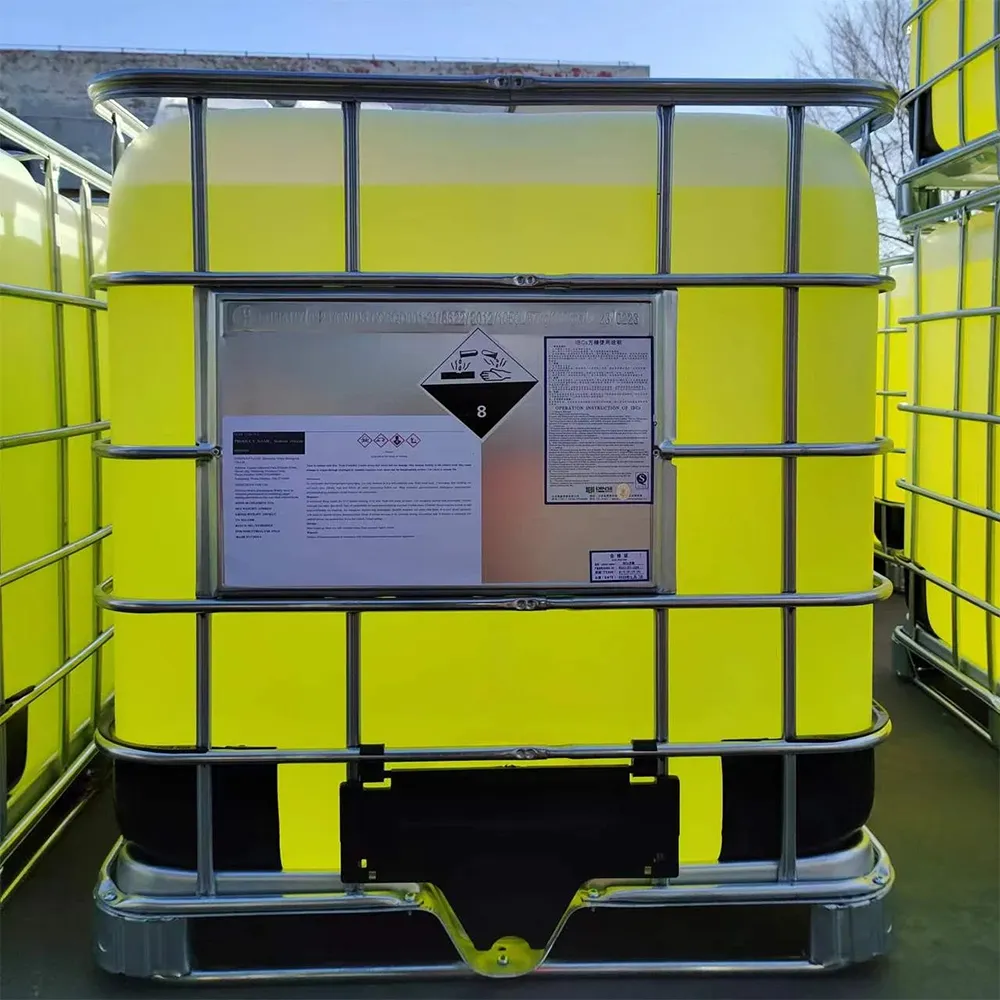



Caustic Soda Flakes MSDS PDF - Safety Data Sheet, High Purity & Industrial Use
- Introduction & Overview of Caustic Soda Flakes MSDS
- Caustic Soda Flakes Properties and Technical Advantages
- Regulatory Framework and Global Safety Requirements
- Comparative Analysis of Leading Manufacturers
- Custom Solutions and Packaging Formats
- Application Case Studies and Best Practices
- Conclusion: The Critical Role of Caustic Soda Flakes MSDS in Industry

(caustic soda flakes msds)
Introduction & Overview of Caustic Soda Flakes MSDS
Caustic soda flakes, also known as sodium hydroxide flakes, have become essential in numerous industrial applications due to their versatility and reactivity. The Material Safety Data Sheet (MSDS) serves as a critical document, summarizing the physical, chemical, and safety characteristics of these chemicals. Users seeking the caustic soda flakes MSDS, as well as the caustic soda flakes MSDS pdf format or detailed MSDS of caustic flakes, must note that proper handling, risk identification, and emergency measures can only be ensured through full adherence to such documentation. Below, we dive into the components of the MSDS, regulatory frameworks, competitive manufacturer analysis, and specific use cases in industrial environments, supported by technical and comparative data.
Caustic Soda Flakes Properties and Technical Advantages
Sodium hydroxide flakes, or caustic soda flakes, are white, odorless, and highly hygroscopic solids. Their purity typically reaches above 98% (NaOH), and they are recognized for their high reactivity, especially with metals and organic compounds. The pH level in a 10% solution exceeds 13, emphasizing their strong alkalinity. Their technical advantages include:
- Industry-leading purity: >98% NaOH content
- Low impurity content: Iron (<20 ppm), Chlorides (<200 ppm)
- Rapid solubility in water, facilitating quick preparation
- High efficacy in saponification, pulp & paper, water treatment, and chemical manufacturing
According to a 2023 industry survey, global demand for caustic soda flakes exceeded 84 million metric tons, with the Asia-Pacific region accounting for 57% of consumption, primarily in textiles, alumina, and detergent sectors.
From a safety perspective, the MSDS highlights:
- Corrosive hazard to skin, eyes, and mucous membranes
- Exothermic reaction with water and acids
- Need for PPE: alkali-resistant gloves, goggles, and face shields
- Specifications for first aid, spill management, and waste disposal
Regulatory Framework and Global Safety Requirements
Regulatory bodies worldwide have established strict requirements regarding the labeling, transportation, and storage of caustic soda flakes. GHS-compliant labeling, UN number 1823, and hazard classifications (Class 8: Corrosive) are standard globally. Documentation, such as the caustic soda flakes MSDS pdf, should be available in both English and local languages depending on jurisdiction.
In the EU, compliance with REACH and CLP regulations is mandatory, whereas OSHA and DOT set standards in the United States. Other key international guidelines include China’s GB/T 1919-2015 for industrial caustic soda and Australia’s Work Health and Safety (WHS) regulations.
Emergency response plans must be in place before onsite storage or handling. According to the CDC, improper storage was responsible for nearly 4% of chemical incident-related injuries in manufacturing in 2022. Proper labeling, secondary containment, and safety training are vital for risk minimization.
Comparative Analysis of Leading Manufacturers
The global caustic soda flakes market is dominated by several key producers, each offering products with specific features and quality standards. Below is a comparative overview of highly reputed manufacturers as of 2024:
| Manufacturer | NaOH Content (%) | Iron Content (ppm) | Chloride Content (ppm) | Annual Capacity (MT) | Compliance Certificates |
|---|---|---|---|---|---|
| Olin Corporation (USA) | 99.1 | <15 | <170 | 5,200,000 | ISO 9001, REACH, GHS |
| Tata Chemicals (India) | 99.0 | <20 | <200 | 2,360,000 | ISO 9001, FAMI-QS, GHS |
| INEOS (Europe) | 98.7 | <22 | <190 | 3,800,000 | ISO 14001, REACH, GHS |
| Xinjiang Zhongtai (China) | 98.5 | <18 | <205 | 2,100,000 | GB/T 19001, GHS |
| Dow Chemical (Global) | 99.2 | <16 | <160 | 4,700,000 | ISO 9001, GHS, OSHA |
Evaluating these manufacturers shows minimal variation in purity and impurity content, yet significant differences exist in annual capacity and regulatory compliance. End users must select suppliers not only based on chemical quality but also certificates relevant to their target jurisdictions.
Custom Solutions and Packaging Formats
The caustic soda market has evolved to serve industries with diverse requirements. Solutions providers and manufacturers now offer multiple packaging options to optimize safety, logistics, and consumption. Common formats include:
- 25 kg PE-lined bags: Widely chosen for small-scale operations and ease of manual handling
- 1,000 kg jumbo bags (FIBC): Best for bulk applications, reducing turnover rates and packaging waste
- Customized drum and tote solutions: For operations with stringent hygiene or contamination control needs
In addition, tailored concentration blends and additive-free products are available upon request. End users from high-precision sectors, such as electronics and pharmaceuticals, often demand low-iron or micro-impurity grades, necessitating customized MSDS documentation and QA/QC protocols.
Vendors often provide technical assistance at the proposal stage, offering alternatives that enhance process efficiency while minimizing chemical hazards.
Application Case Studies and Best Practices
Case 1: Water Treatment Facility in Germany
An advanced municipal water treatment plant adopted high-purity caustic soda flakes to optimize their pH control processes. After implementation, scale build-up dropped by 38%, and chemical usage efficiency increased by 14% over a 12-month period.
Case 2: Pulp and Paper Mill, Canada
Facing low pulp yield and rising energy costs, the facility switched suppliers to a product listed with a detailed MSDS of caustic flakes, including technical purity and handling risks. The result was a 9% increase in paper brightness and a 6% reduction in chemical consumption per ton of pulp.
Case 3: Textile Processing (India)
A major textile operation used a custom grade, sourced with full MSDS disclosure. Worker incidents linked to chemical burns fell by 47%, while system downtime due to cleaning was reduced by 23% versus the previous year.
Across industries, integrating expert-reviewed safety protocols and routine MSDS training is recognized as a leading measure for reducing workplace risk and improving operational reliability.
Conclusion: The Critical Role of Caustic Soda Flakes MSDS in Industry
The availability and accurate implementation of caustic soda flakes MSDS information act as a cornerstone for safety and operational excellence wherever sodium hydroxide flakes are deployed. Various sectors benefit from informed supplier selection, compliance with international standards, and the adoption of proven best practices detailed in these safety documents. As regulations evolve, maintaining up-to-date MSDS records and consistent training will remain fundamental to safeguarding both workforce and production assets.

(caustic soda flakes msds)
FAQS on caustic soda flakes msds
Q: What is the MSDS for caustic soda flakes?
A: The MSDS for caustic soda flakes outlines safety, handling, and storage information for this chemical. It provides details on potential hazards and first aid measures. Always refer to the MSDS before use.Q: Where can I find a caustic soda flakes MSDS PDF?
A: You can usually download a caustic soda flakes MSDS PDF from chemical suppliers or manufacturer websites. Regulatory agencies and safety data portals also provide them. Make sure you access the latest version.Q: What are the main hazards listed in the MSDS of caustic flakes?
A: The MSDS of caustic flakes lists skin and eye irritation, burns, and respiratory risks as primary hazards. It emphasizes the need for protective equipment. Always read the hazard section before handling.Q: Is it necessary to use PPE when handling caustic soda flakes according to the MSDS?
A: Yes, the MSDS for caustic soda flakes strongly recommends using personal protective equipment (PPE). This includes gloves, eye protection, and face shields. PPE helps prevent burns and serious injuries.Q: Why is it important to review the caustic soda flakes MSDS before use?
A: Reviewing the MSDS of caustic flakes ensures you know the risks, safe handling methods, and emergency procedures. It helps protect your health and safety. Always consult the MSDS before working with chemicals.-
Why Sodium Persulfate Is Everywhere NowNewsJul.07,2025
-
Why Polyacrylamide Is in High DemandNewsJul.07,2025
-
Understanding Paint Chemicals and Their ApplicationsNewsJul.07,2025
-
Smart Use Of Mining ChemicalsNewsJul.07,2025
-
Practical Uses of Potassium MonopersulfateNewsJul.07,2025
-
Agrochemicals In Real FarmingNewsJul.07,2025
-
Sodium Chlorite Hot UsesNewsJul.01,2025










